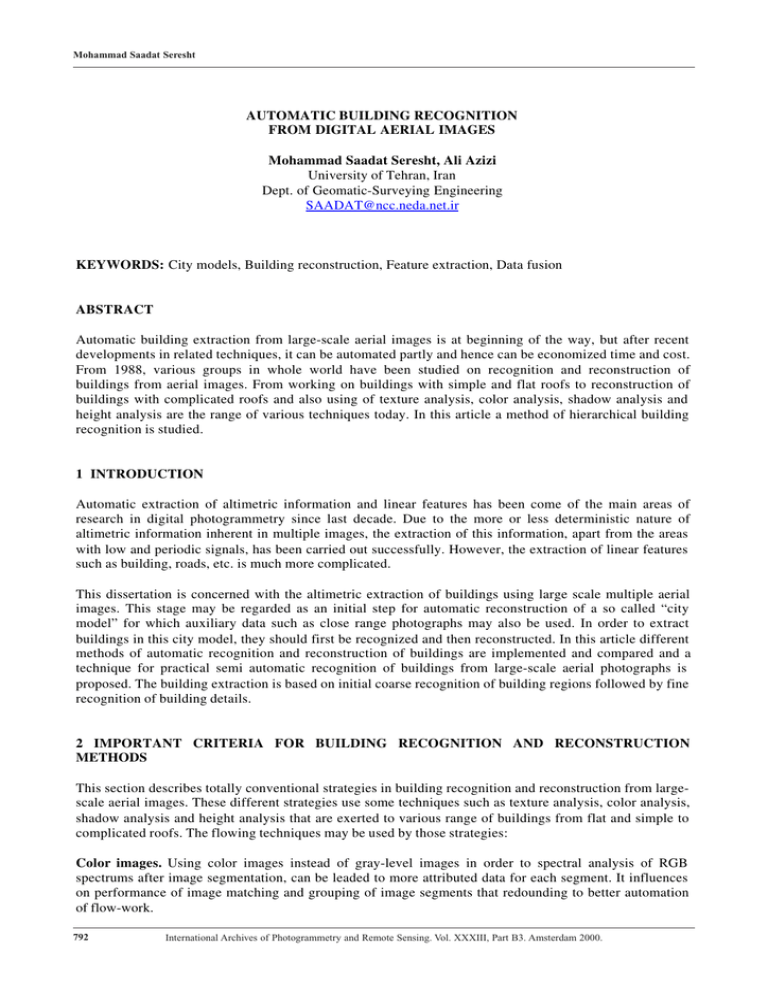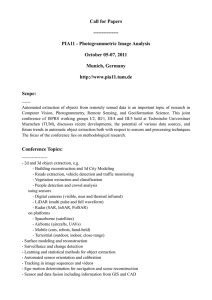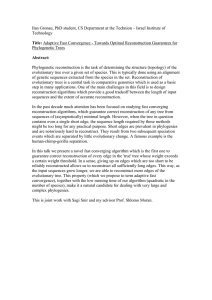AUTOMATIC BUILDING RECOGNITION FROM DIGITAL AERIAL IMAGES Mohammad Saadat Seresht, Ali Azizi KEYWORDS:
advertisement

Mohammad Saadat Seresht AUTOMATIC BUILDING RECOGNITION FROM DIGITAL AERIAL IMAGES Mohammad Saadat Seresht, Ali Azizi University of Tehran, Iran Dept. of Geomatic-Surveying Engineering SAADAT@ncc.neda.net.ir KEYWORDS: City models, Building reconstruction, Feature extraction, Data fusion ABSTRACT Automatic building extraction from large-scale aerial images is at beginning of the way, but after recent developments in related techniques, it can be automated partly and hence can be economized time and cost. From 1988, various groups in whole world have been studied on recognition and reconstruction of buildings from aerial images. From working on buildings with simple and flat roofs to reconstruction of buildings with complicated roofs and also using of texture analysis, color analysis, shadow analysis and height analysis are the range of various techniques today. In this article a method of hierarchical building recognition is studied. 1 INTRODUCTION Automatic extraction of altimetric information and linear features has been come of the main areas of research in digital photogrammetry since last decade. Due to the more or less deterministic nature of altimetric information inherent in multiple images, the extraction of this information, apart from the areas with low and periodic signals, has been carried out successfully. However, the extraction of linear features such as building, roads, etc. is much more complicated. This dissertation is concerned with the altimetric extraction of buildings using large scale multiple aerial images. This stage may be regarded as an initial step for automatic reconstruction of a so called “city model” for which auxiliary data such as close range photographs may also be used. In order to extract buildings in this city model, they should first be recognized and then reconstructed. In this article different methods of automatic recognition and reconstruction of buildings are implemented and compared and a technique for practical semi automatic recognition of buildings from large-scale aerial photographs is proposed. The building extraction is based on initial coarse recognition of building regions followed by fine recognition of building details. 2 IMPORTANT CRITERIA FOR BUILDING RECOGNITION AND RECONSTRUCTION METHODS This section describes totally conventional strategies in building recognition and reconstruction from largescale aerial images. These different strategies use some techniques such as texture analysis, color analysis, shadow analysis and height analysis that are exerted to various range of buildings from flat and simple to complicated roofs. The flowing techniques may be used by those strategies: Color images. Using color images instead of gray-level images in order to spectral analysis of RGB spectrums after image segmentation, can be leaded to more attributed data for each segment. It influences on performance of image matching and grouping of image segments that redounding to better automation of flow-work. 792 International Archives of Photogrammetry and Remote Sensing. Vol. XXXIII, Part B3. Amsterdam 2000. Mohammad Saadat Seresht DSM. Height information is used for automatically recognition of approximate location and region of buildings. After that, we know each recognized region include only one building that with assistance of image data, details of building can be extracted and modeled. 3D modeling. Buildings are modeled three dimensionally in this method that is more complicate but usable for more various types of buildings. In this method, feature matching and grouping with help of topology rules and Euler operators are done three dimensionally in model space instead of two dimensionally in image space. Therefore we can reconstruct complicate building roofs by extraction and setting of 3D faces. Shadows. Analyzing of image shadows are used to building recognition. Operator interaction. In semi-automatic methods that are more operational, operator interaction for building recognition and reconstruction causes to improvement of production reliability and reconstruction of more types of buildings. Usually in this method, first, a set of building models has been grouped. Operator after pointing to each building on images and related model in generic models prepares work for computer interaction. At last, result is compared with fact and then reconstructed building is succeeded or improved by operator. Special building models. This method enables us to reconstruct buildings with specific shapes such as gable, pyramidal or hemispherical roofs. In this method, we can reconstruct buildings after introducing of roof model and related parameters. Flat building roofs. Edges of building about are extracted in this method (for example with existence maps) and only with one height point on its roof a 3D representation of building is created. Note to be that flatness of building roofs is default. Rectangular shaped buildings. In this method a rectangle is fitted to building plan based on least square estimation and 2D modeling is done in image space. 3 COARSE RECOGNITION OF BUILDING REGIONS Basically, for automatically recognition of building regions in images, have to be used altimetric information in addition to planimetric information, because singly using of images can not completely lead us for building recognition. It is due to occluded areas, types of texture and shadow, low contrast and complexity of image regions. Also DSM is made from stereo image matching process that is selfsame of DTM plus all features on and near surface of the earth. Therefore with help of DSM we can partly inhibit above problems. The first step in coarse recognition of building regions is detachment of 3D local ridges regions of DSM. Then some filters are applied on selected regions based on their shape, size and content to reliability on existence of a building in regions is raised and building hypotheses are made. There are five methods for 3D-region segmentation: Smoothed ridges extraction 3D-edges extraction of DSM DTM from DSM differentiation DSM classification with contour lines that is alleged MHB (multiple height bins) DSM classification with region filling Recognized ridges in DSM can be related to various 3D features. In order to decrease of mistakes in coarse recognition of building areas, deletion of absurd ridges and problems are not occurred in recognition of building details, a number of tests are needed to applied on these areas. Therefore default in step of fine recognition is existence of one building at each specific region. A number of tests that are applied this step due to 3D regions filtering are flowing: Object space filtering includes: Minimum height above the earth surface International Archives of Photogrammetry and Remote Sensing. Vol. XXXIII, Part B3. Amsterdam 2000. 793 Mohammad Saadat Seresht Minimum size of region (wide and length) Area and perimeter of region Elongation scale of region Number of holes in region (Euler number) Shape analysis of region (e.g. based on Fourier descriptors of edges of region) Image space filtering includes: The number and length of long straight lines Histogram of edge elements orientations Texture analyze Color analyze 4 FINE RECOGNITION OF BUILDING After coarse recognition of building areas and assurance to existence of only one building in each region, the more complex step i.e. fine recognition is stared. Unlike to previous step, this step specially adverts to pictorial data but height information of DSM can be used to preparation of approximated information, improvement of reliability or testing of results. In semi-automatic methods, recognition of building area is manually but recognition of building details is automatically. Basic tools for fine recognition are image features that are including of key-points, edges, lines and regions. Selection of Type and level of feature extraction has right relation with accuracy and method of reconstruction. Also straight lines are usually basic characteristic of conventional building with regular edges. Fine recognition may be done with other methods such as corner analysis, using of line relation graph and/or color and shadow analysis. 4.1 Key-Point Extraction Point detection operators must be applied as soon as after preprocessing. Due to size of operator's window, each key point is represented to cluster that the best answer is local maxima. These local maxima keypoints extract by applying a suitable threshold after deletion of their remained neighbors. Of course in order to more improvement in key point detection it is divided to some sub-segment and in each one is calculated and applied related threshold. Different operators for detection of key points are introduced such as Deriche & Giraudon method for point detection, Asada & Brady or Medioni & Yasumoto methods for detection of corner points and Heitger, Robbins & Owens, Forstner or Moravec that are suitable detectors for each types of intersection, corner and centroid key points. But Forstner and Moravec operators have been come of the best key-point detection operators for feature based matching of aerial images. Whiles Forstner Operator has some improvement related to Moravec operator because operation of Forstner operator is independent than relative orientation of images. This is not a considerable benefit in aerial images because exterior orientation of images in a strip is very similar. Also this operator enable to estimate subpixel accuracy in the best way. In Forstner method each key-point is described by two attributes that are suitable for feature based matching of images. 4.2 Line Extraction Straight-line extraction is a sensitive step in fine recognition of regular edge buildings. After cleaning of extra line segments and connecting of their corners, straight lines of building edges are created and so Line extraction processing is done in each region. The steps of processing are flowing: Edge detection Edge thinning Edge linking Line fitting to edges Unsuccessful line segments cleaning Corners connection 794 International Archives of Photogrammetry and Remote Sensing. Vol. XXXIII, Part B3. Amsterdam 2000. Mohammad Saadat Seresht Totally, we can use five groups of edge detection methods include: Gradient-based methods Zero-crossing methods Moment-based methods Surface fitting methods Model Matching methods The simplest and most widespread methods are gradient-based methods that detect edges by differentiation operators. Some of these operators are includes Roberts, Prewitt, Sobel, isotropical, diametrical or statistical operators. Sobel operator is probably the best operator because its sensitivity is proportional to distance and orientation of neighbors pixels and also has improvement for smoothness and differentiate estimation. Sobel operator has been ingratiated because first gradient is much less sensitivity to noise and it can control influence of the noise by varying size of operator window that control smoothness. The edges have to be thinned in order to positioning accurately. Some methods of edge thinning are includes: Skeleton line extraction Morphologic operators Canny methods The output of this step is edges with one pixel wide. In edge linking step, a list of sequential edge elements for each edge is acquired that is used for next processing. In some of edge detection methods, edge are linked simultaneously e.g. LoG method that extract closed curve edges or graph-theory techniques that the low-cost path is derived on edges based on graph theory and cost function definition. The techniques of edge detection that are based on threshold, usually have some gaps in edges that must be modified with post processing of edge linking. A technique of edge linking specially in edge detection techniques based on gradient is using of orientation, strength and location of edge elements. Orientation of edge elements can be derived from orientation of gradient vector. If Difference of orientation of two sequential pixels is less than a suitable threshold, then it is edge element. In order to better and more accurate representation, straight lines have to be fitted on edges to object boundaries are completed and geometric processing can be applied easily. The techniques of line fitting are includes: Polyline composition algorithm Polyline decomposition algorithm Tolerance based algorithm Hop-Along algorithm The next step is final cleaning process that a number of these processing are includes: Linking of line segments that are coincide on a straight line Deletion of irrational edge segments Accurate identification of corners and linking of edges Grouping of linked edges Composition of edges with 3D points After cleaning and linking of edges that are based on characteristics of edge such as its orientation, straight and location, corners must be identified accurately and over/under-shoot of sides must be cleaned on these corners. 4.3 3D Lines Creation of Building Edges 3D straight lines have been attended, because they are an important characteristic of man-made objects such as conventional buildings. In order to extraction of these 3D lines, 3D points and 2D lines of each region are extracted. 3D-coordinates of key-points are derived by image matching process and 2D lines are extracted by feature extraction techniques. After that, 2D line are coincided on two or more 3D points and at last 3D lines are made and then are used for building modeling in reconstruction step. International Archives of Photogrammetry and Remote Sensing. Vol. XXXIII, Part B3. Amsterdam 2000. 795 Mohammad Saadat Seresht Other techniques of 3D-line extraction are line matching. In this case, we can derive approximate parallax of stereo lines from DSM. 5 BUILDING RECONSTRUCTION After coarse recognition of building regions and fine recognition of building details, reconstruction step is started. Before reconstruction step, extracted features have not been depended together and can not be supposed an object named, building. But after reconstruction step, these features as well as DSM data and other exterior information (e.g. knowledge about shape of building or using of side images) can be built a representation of building. Definition of reconstruction is a 3D geometric description of building in requirement level of details. This 3D geometric description needs 3D geometric modeling that has several methods (figure 1). Geometric Modelling Graphic-Based Modelling Surface-Based Modelling Non-Composition Model Solid-Based Modelling Constructive Model Boundary Model Figure 1. Types of geometric modeling In building reconstruction we have several methods that are related to following parameters: Building types: From simple rectangle with flat floor to much more complicated building shape Level of details: From building blocks to single buildings with ridge, gable, chimney and dormer Number of Images: From stereo images to multiple images Type of image cue: Such as color, texture, or shadow and reflectance Primitives: Such as points, 2-leg or 3-leg vertex, lines and homogeneous regions Existence information: Such as other sensors data, DTMs, DSMs, maps or GIS data Automation level: From manual to full automatic Processing space: From full 3D processing to composition of 2D and 3D processing Geometric conditions: Such as pre-knowledge about building, its geometry and functionality e.g. right angle, parallel/straight lines, sensor geometry, sun location and so on Totally in reconstruction step, geometric models either are predefined e.g. generic models or are created directly by extracted features in required level of details. No specific model of geometric modeling does it. In relation with this, DSM id very good help for approximate modeling that can be used for starting point in reconstruction and therefore it improves reliability of reconstruction. At last it note be that, because building have different shape and complexity, operators don’t have skill on understanding of system and density and complexity of building regions, building can not be reconstructed completely. Therefore it is better that, in addition to using of above algorithms, a method of control is applied e.g. simultaneously 3D viewing of scene as well as reconstructed building representation. 6 EXPERIMENTS Input data are large-scale stereo images (1:3000 scale) and DSM with height intervals of 1 and 5 meters respectively and output is linear features of each building to be used in reconstruction step. In figure 2, output of each section is represented: a) sample of building region b) related DSM c) automatic classification of DSM by seed filling method d) using of building recognition image filters and fining 3D region boundaries e) projecting up 3D region boundaries on images by collinearity condition f) edge 796 International Archives of Photogrammetry and Remote Sensing. Vol. XXXIII, Part B3. Amsterdam 2000. Mohammad Saadat Seresht extraction by Candy & Sobel composition method g) histogram of edge orientation testing of building existence in region h) key-point extraction by Moravec method i.) line extraction and fitting. Figure 2: Outputs of test 7 CONCLUSIONS AND RECOMMENDATION Coarse recognition of building regions and fine recognition of building details are two sequential steps that offer a top-down idea for building recognition. This techniques results on improvement of reliability and simplicity of work because if we know to exist only one building in selected region then much more problems are obviated later. Basic problems of coarse recognition of building regions are includes near or connected buildings, occluded areas and covered objects e.g. trees and recognition of dooryard of building that often hardly are solved or are not solved. Because existing methods for building recognition and reconstruction are at beginning of way and still are not solved completely, suggest that all aspects of it are studied for example multiple image techniques, fusion of GIS data, using DSM for reconstruction, generic modeling by roof decomposition and working on more efficient semi-automatic methods. Non-parametric methods are recommended for building extraction because these techniques are very enable for complicate building that can not be modeled. In future studies, it is better to concentrate on data fusion because today variety sources of data are available. The test results show that automatic coarse recognition of individual and simple building regions is achievable. More complicated buildings, connected buildings and neighborhood features such as trees, may ruin the recognition. Since in Iran majority of buildings is connected, their recognition and reconstruction may be the subject of further studies. REFRENCES Baltsavias E., Mason S., Stallmann D., 1995. Use Of DTMs/DSMs and Orthoimages to Support Building Extraction. Automatic Extraction of Man-Made Objects from Aerial and Space Images, p. 199-210. International Archives of Photogrammetry and Remote Sensing. Vol. XXXIII, Part B3. Amsterdam 2000. 797 Mohammad Saadat Seresht Gruen A., 1997. Automation in Building Reconstruction. Photogrammetry Week 1997, p. 175-186. Halla N., 1995. 3D Building Reconstruction Using Linear Edge Segments. Photogrammetry Week 1995, p. 19-28. Halla N., Hahn M., 1995. Data Fusion for the Detection and Reconstruction of Buildings. Automatic Extraction of Man-Made Objects from Aerial and Space Images, p. 211-220. Henricsson O., 1996. Analysis of Image Structures Using Color Attributes and Similarity Relations. Ph.D. Thesis, ETH, Zurich. 798 International Archives of Photogrammetry and Remote Sensing. Vol. XXXIII, Part B3. Amsterdam 2000.






